Brand Stories: 5 Compelling Examples That Sell Themselves (Part 2)
(see Part 1 here)
“Exactly how do I tell my brand’s story?” is one of the most frequently asked questions we receive. Simply start at the beginning and consider the following guides as you draft out the core ingredients of your brand story:
- Do: Tell a story
- Don’t: Fudge the facts
- Do: Use visuals and photos
- Don’t: Use copyrighted photography
- Do: Use numbers
- Don’t: Write a novel
- Do: Show your brand’s personality[1]
If you’re struggling with writing the heart of your compelling brand story so it’s shared time and time again by word-of-mouth then the Persona Brand Building Blueprint™ Mastermind is the perfect fit for you. There are ten key areas we focus on during this two day brand building intensive all of which are fully immersive and strategic in nature. Your brand story is one of the core areas of immersion.
If you want to transform your brand and increase your sales then this two day intensive shared with a small group of like-minded peers is a must for you so you can take your brand further, faster.
More information and registration for the Persona Brand Building Blueprint™ Mastermind can be found here.
The Small Business Brand Advantage
Small businesses are at an advantage. Everyone can identify with an authentic, personal story in a way that big brands cannot achieve. We commonly see these kind of ‘About Us’ write-ups on the websites of SME’s, and they’re just about right.
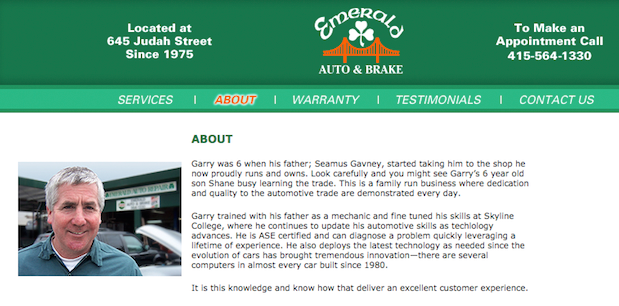
Image via Emerald Auto and Brake and Vertical Response
Small to medium-sized businesses can also tell a brief personal story about each employee, another opportunity to claim real estate on the web, to create pride among staff, to introduce ice-breakers for clients, and to humanize the brand — an opportunity not to be overlooked.

Image via Marker Real Estate
In part one of this blog title, we introduced 5 exceptional big brand storytelling examples: Airbnb, Amazon, Dollar Shave Club, Facebook, and Guinness. Part two takes a look at five more brands that have hit the nail on the head and discusses universal takeaways for marketers of brands, no matter what size.
Brand: Harry Potter
Backstory:
Author JK Rowling’s own story is one of rags to riches, from living on state benefits, catapulted to multi-millionaire status within five years. The book grew into a series, the series became blockbuster films, and then came the theme parks and global entertainment franchising…some real magic indeed.
Problem:
Literacy. James Thomas, professor of English at Pepperdine University, says the books do more than entertain. “They’ve made millions of kids smarter, more sensitive, certainly more literate…I don’t know of any books to have worked that kind of magic on so many millions of readers in so short a time in the history of publications.”[2]
Solution:
Perfect timing, perfect emotional connection. “Harry Potter and the Philosopher’s Stone,” released in the UK in June 1997, was the first book in decades that schoolboys (including those who weren’t avid readers) just couldn’t put down. At that time, the internet was dial-up, Google wasn’t yet founded, and Nintendo 64 had only just hit the shelves. The thriller storyline of Harry Potter books delivered addicting fantasy adventure in large, un-Disney, doses.
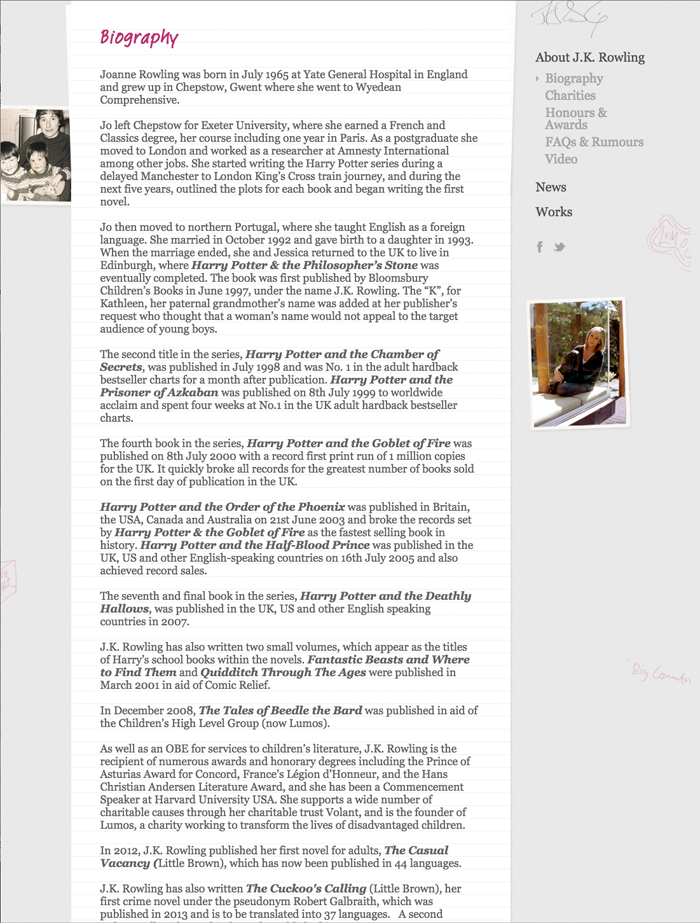
Image via JK Rowling
Success:
The Harry Potter brand is worth $25 billion. The movies grossed $7.7 billion worldwide and the best-selling series of books in history, translated into 73 languages, have made just as much. J.K. Rowling has been named the world’s richest author, with a net worth of $1 billion.[3]
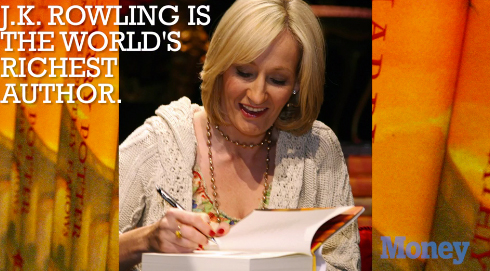
Image via Money Magazine
Takeaway:
Start small, be patient, persevere. Bloomsbury offered JK Rowling $2,250 and agreed to print 1,000 books after she’d been turned down by many other publishers.
Brand: SoulCycle
Backstory:
A decade ago, SoulCycle was a boot-strapped startup by two mothers who met over lunch and decided there was a hole in the market for fitness classes that didn’t require a gym membership.
Problem:
Gyms are everywhere. Why would anyone need another fitness centre chain that only offers 45-minute cycling classes? Or, is a no-membership fee model enough to carve out success?
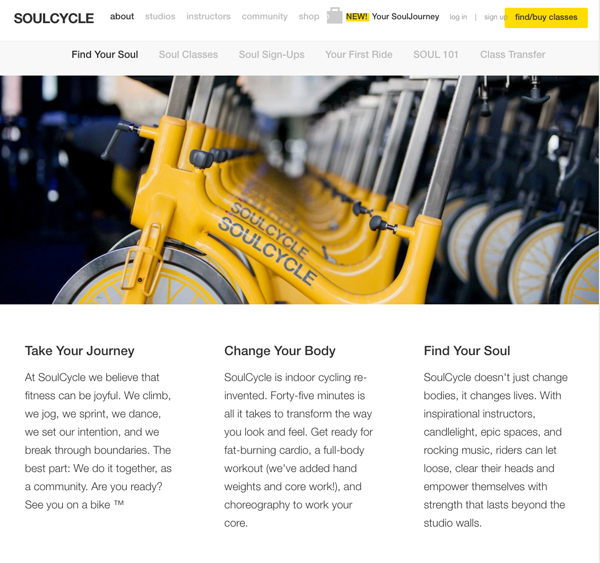
Image via SoulCycle
Solution:
Imagine a darkened room lit by candles scented of citrus, rows of stationary bikes, deafening music pumping away, a good-looking, fit, inspirational instructor urging you to spin faster in your special shoes clipped onto the pedals of a yellow bike with wheels decorated like a lemon. That’s SoulCycle…it’s meant to go beyond a workout — to be good for your body and nourish your soul. It’s as much a cult as a class, thanks to a deeply loyal following that’s sprinkled with celebrities.
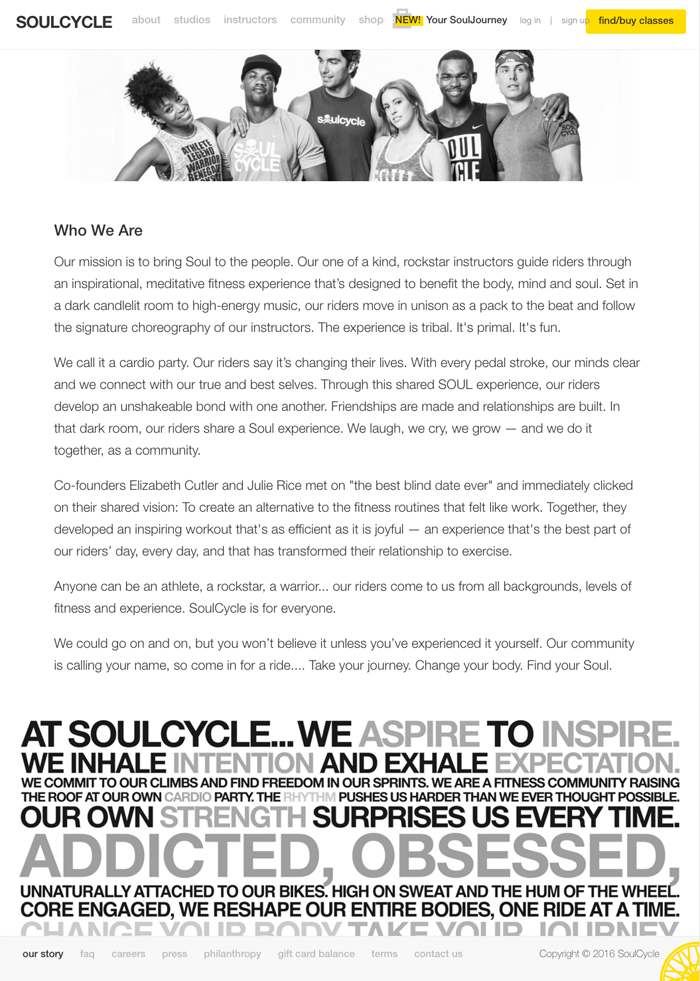
Image via SoulCycle
Success:
A leader in the luxury exercise trend. Nearly 70 prime studio locations in 11 states, concentrated in New York City and California, which accounted for 97 percent of the $112 million in revenue in 2014, 50 percent higher than the year prior.[4] Equinox purchased a majority stake of 97 percent and the two founders walked away with $90 million each.
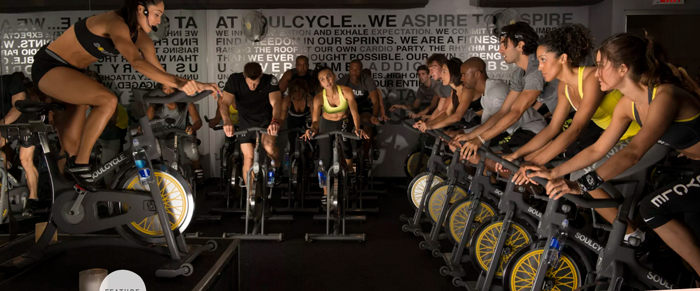
Image via Racked and SoulCycle
Takeaway:
Relate to a niche audience and put a spin (pun intended) on a core product. Wearing the tagline, “Aspirational lifestyle brand,”[5] SoulCycle markets itself as “the place people come, regardless of their age, athletic ability, size, shape, profession or personality, to connect with their best selves.”[6] In 2016, Fast Company placed SoulCycle on its list of the World’s 50 Most Innovative Companies.[7]
Brand: Spanx
Backstory:
“Spanx founder Sara Blakely was getting ready for a party when she realized she didn’t have the right undergarment to provide a smooth look under white trousers. Armed with scissors and sheer genius, she cut the feet off her control top pantyhose and the Spanx revolution began.”[8]
Problem:
Eliminating VPL (visible panty line) and offering an alternative to uncomfortable body shapers.
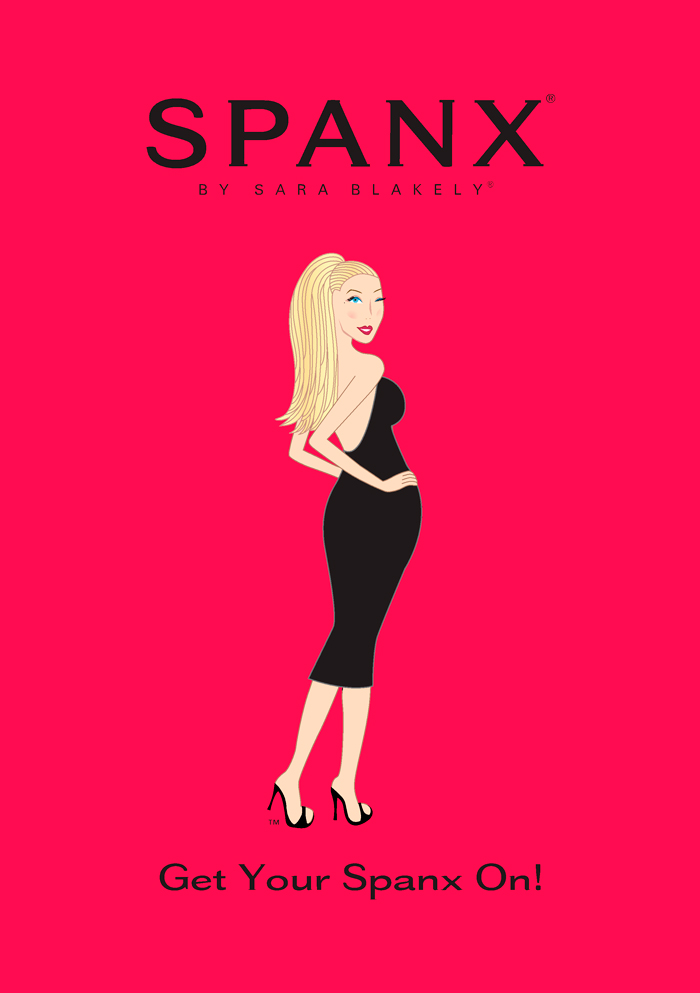
Image via Spanx
Solution:
Armed with $5,000, a focus on solving wardrobe woes, and a brand persona (meet Sunny) to make the packaging stand out, the Spanx brand has grown to offer dozens of products including leggings, bras, maternity shapewear, a men’s line and more.
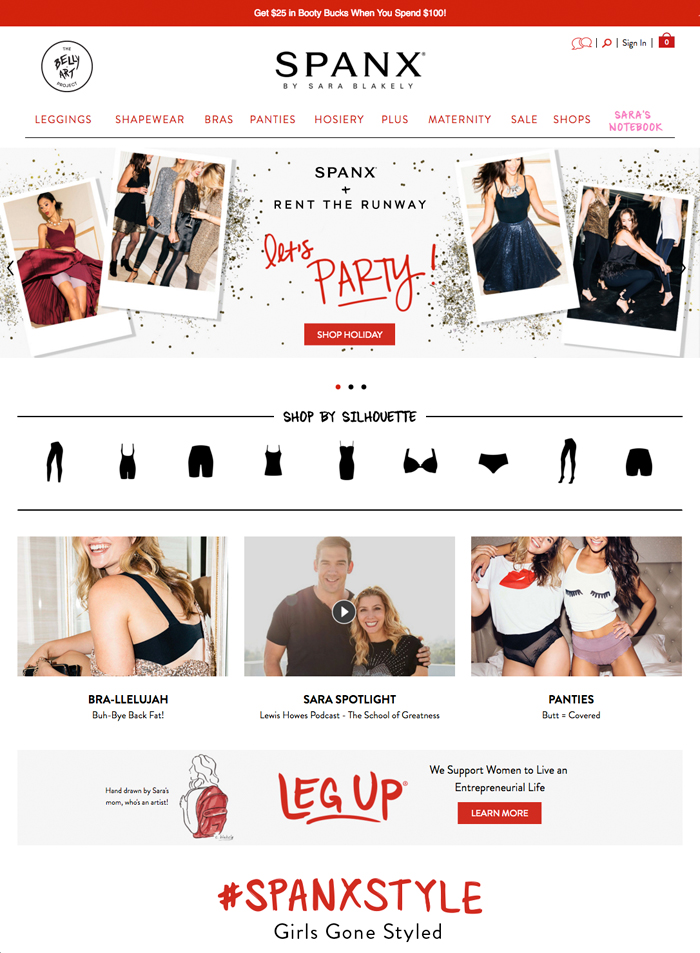
Success:
Meet America’s youngest female self-made billionaire. With annual sales of $400 million-plus[9], Sara Blakely’s nonprofit foundation has contributed $24 million to women’s causes.
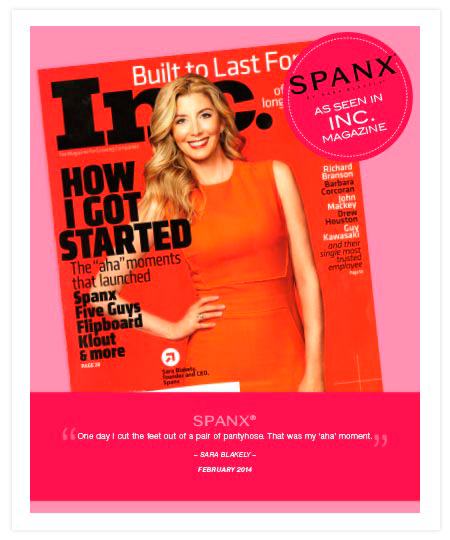
Image via Spanx
Takeaway:
On the pages of a trusty spiral notebook, the kind where her first scribbles and notes appeared in 2000, Sarah Blakely keeps the narrative going with “Years of Great Rears” published on the Spanx website.
Brand: Uber
Backstory:
The app-based car service was hatched pretty much on the back of the napkin, according to Travis Kalanick, co-founder of Uber. The co-founders were a couple of serial entrepreneurs hanging out together after hours during a tech conference in Paris.[10]
Problem:
People want reliable, affordable, fast door-to-door taxi service. San Francisco had a notoriously lousy taxi service, where Uber was launched as an experiment in 2010 following a three-car trial in Manhattan.
Solution:
One long-time user explains the Uber lifestyle thinking:[11]
- They realized they’re not a transportation company, but a logistics company to dispatch things to people who want them. Usually it’s cars, but sometimes it’s ice cream, a mariachi band, or even kittens from shelters.
- If you can do it in San Francisco, you can do it in New York, Los Angeles, Chicago, Sydney, Paris, and anywhere in between.
- Since a lot of people use the service not because of how good it is, but how bad taxis are let’s make a cheaper option.
Plus, you don’t need cash. You just hop out.
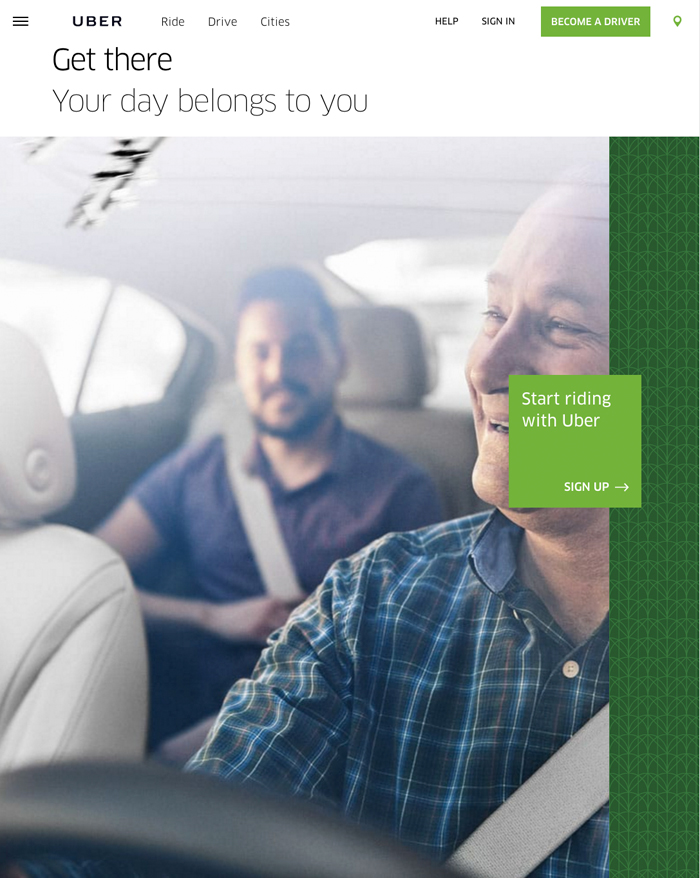
Image via Uber
Success:
Uber is one of the world’s fast-growing companies. Currently valued at $63 billion, Uber operates in 527 cities in 77 countries.[12] However, like Airbnb, another giant industry disruptor, the area in which Uber struggles is regulatory; there is room for improvement in their storytelling.
Takeaway:
Kalanick says, “Transportation should be like running water and we want to make that happen absolutely everywhere, for everyone.”[13] Make sure your brand has clearly identified its core message and crafted a story to tell it well. Furthermore, keep the narrative up-to-date if and when external factors impact it.
Brand: Warby Parker
Backstory:
One of four co-founders from Wharton Business School, Neil Blumenthal, explains the idea came when a friend left a $700 pair of glasses in an airline seat pocket. Having seen how cheap glasses are made in Asia at the same factory that made the expensive ones, Blumenthal imagined a lifestyle brand that addresses price, style and the need for an optometrist visit.[14]

Image via Warby Parker
Problem:
As a technology that had been around for about 800 years, modern eyeglasses were needlessly expensive. Why? Because the industry was monopolized by one giant company. Warby Parker says everybody has a right to corrective lenses that are fun, free, and affordable.
Solution:
Warby Parker transformed the eyeglasses industry by designing in-house, selling direct-to-consumer to avoid retail markups and offering a free try-on at home service by mail. In addition, CSR is also at the heart of this brand story, for every pair of frames sold one pair is distributed to someone in need. So, “Buy a pair, give a pair.”
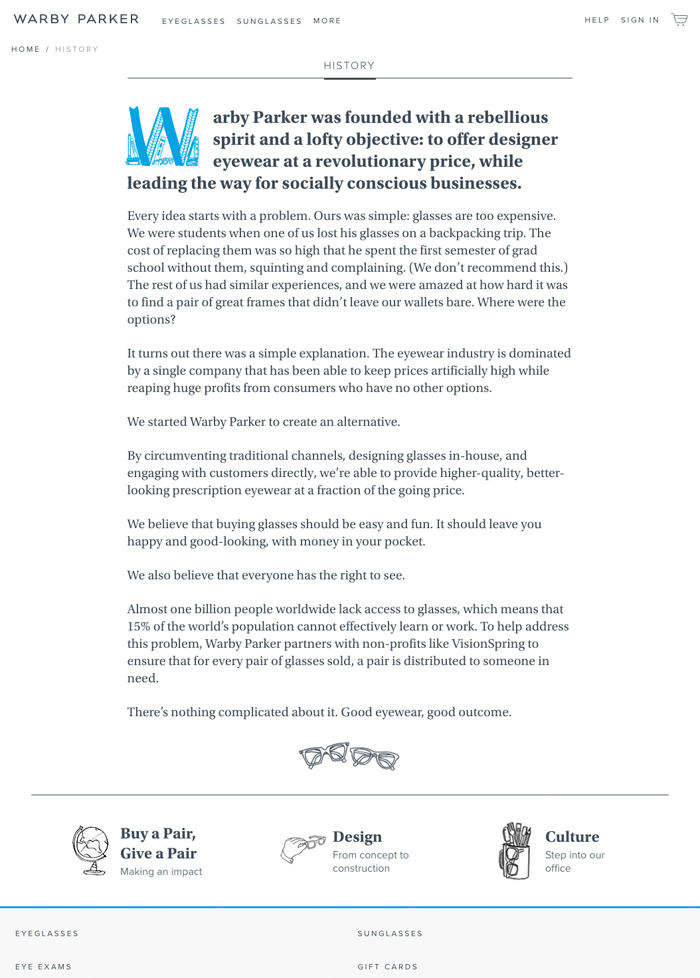
Image via Warby Parker
Success:
Eyeglasses for $95 was a groundbreaking proposition and an overnight success. Word-of-mouth took off (15 percent of the population wears glasses). Warby Parker now has 42 locations in North America in addition to e-commerce; the company founded in 2010 was valued at $1.2 billion in 2015.[15]
Takeaway:
Every brand idea starts with a problem. Express yours in plain language, such as this: “We believe that buying glasses should be easy and fun. It should leave you happy and good-looking, with money in your pocket. We also believe that everyone has the right to see.”
Want to write your compelling brand story? Want to attract your ideal customers so you can sell your brand way more effectively? The Persona Brand Building Blueprint™ Mastermind is the perfect fit for you. There are ten key areas of immersion we focus on during this two day brand building intensive, one of which is your brand story. You work on your brand over the two days with our direction so you can seriously accelerate your growth.
If you want to transform your brand and increase your sales then this two day intensive shared with a small group of like-minded peers is a must for you so you can take your brand further, faster.
More information and registration for the Persona Brand Building Blueprint™ Mastermind can be found here.
Six Questions For Brand Owner Managers to Consider About Brand Storytelling
- Have your defined your brand’s story and found a compelling way to share it with your customers and potential customers?
- Does your brand story present and solve a unique problem?
- Is your story told in an authentic human voice rather than a corporate one?
- Is there an emotional connection in your brand storytelling?
- Does your brand story have a beginning, middle and an end? Lastly, is there a call to action?
- Have you considered getting input from your customers to help you determine your brand messaging? Their feedback can help you clarify and define the voice behind your company.
[1] http://www.verticalresponse.com/blog/7-dos-and-donts-for-writing-your-companys-story
[2] http://content.time.com/time/specials/2007/personoftheyear/article/0,28804,1690753_1695388_1695436,00.html
[3] http://time.com/money/4279432/billion-dollar-spell-harry-potter
[4] http://www.dailymail.co.uk/news/article-3531018/SoulCycle-founders-resign-company-year-making-90-million-selling-Equinox.html
[5] http://www.latimes.com/business/la-fi-soulcycle-ipo-20150731-story.html
[6] http://www.nytimes.com/2015/08/09/upshot/soulcycle-you-say-cult-i-say-loyal-customer-base.html?_r=1
[7] https://www.fastcompany.com/most-innovative-companies
[8] http://www.spanx.com/about-us
[9] http://www.philly.com/philly/business/20161011_Reuters_tagreuterscom2016newsmlMT1VRT1201884257_Spanx_Founder_Sara_Blakely_Gives_Back_to_Empower_Women__Small_Businesses.html
[10] https://newsroom.uber.com/ubers-founding
[11] https://www.quora.com/What-is-the-story-behind-the-creation-of-Uber
[12] http://uberestimator.com/cities
[13] https://www.marketingweek.com/2015/09/17/uber-ceo-we-need-to-get-better-at-telling-our-story
[14] https://techcrunch.com/2013/05/07/the-three-things-warby-parker-did-to-launch-a-successful-lifestyle-brand
[15] http://www.forbes.com/sites/stevedenning/2016/03/23/whats-behind-warby-parkers-success/#7d24b3406395

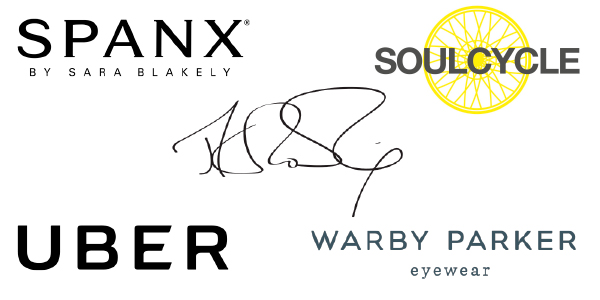
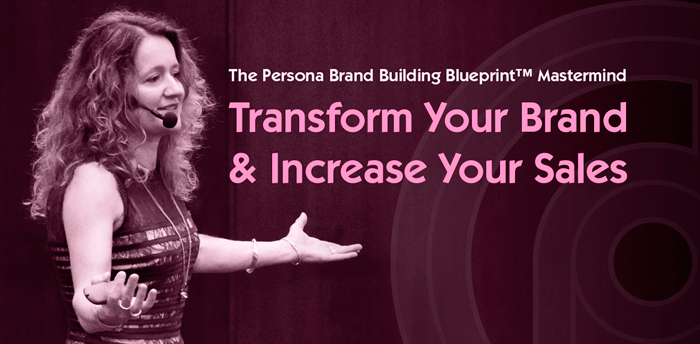





Leave a Reply
Want to join the discussion?Feel free to contribute!